1976 Brazilian Grand Prix race report
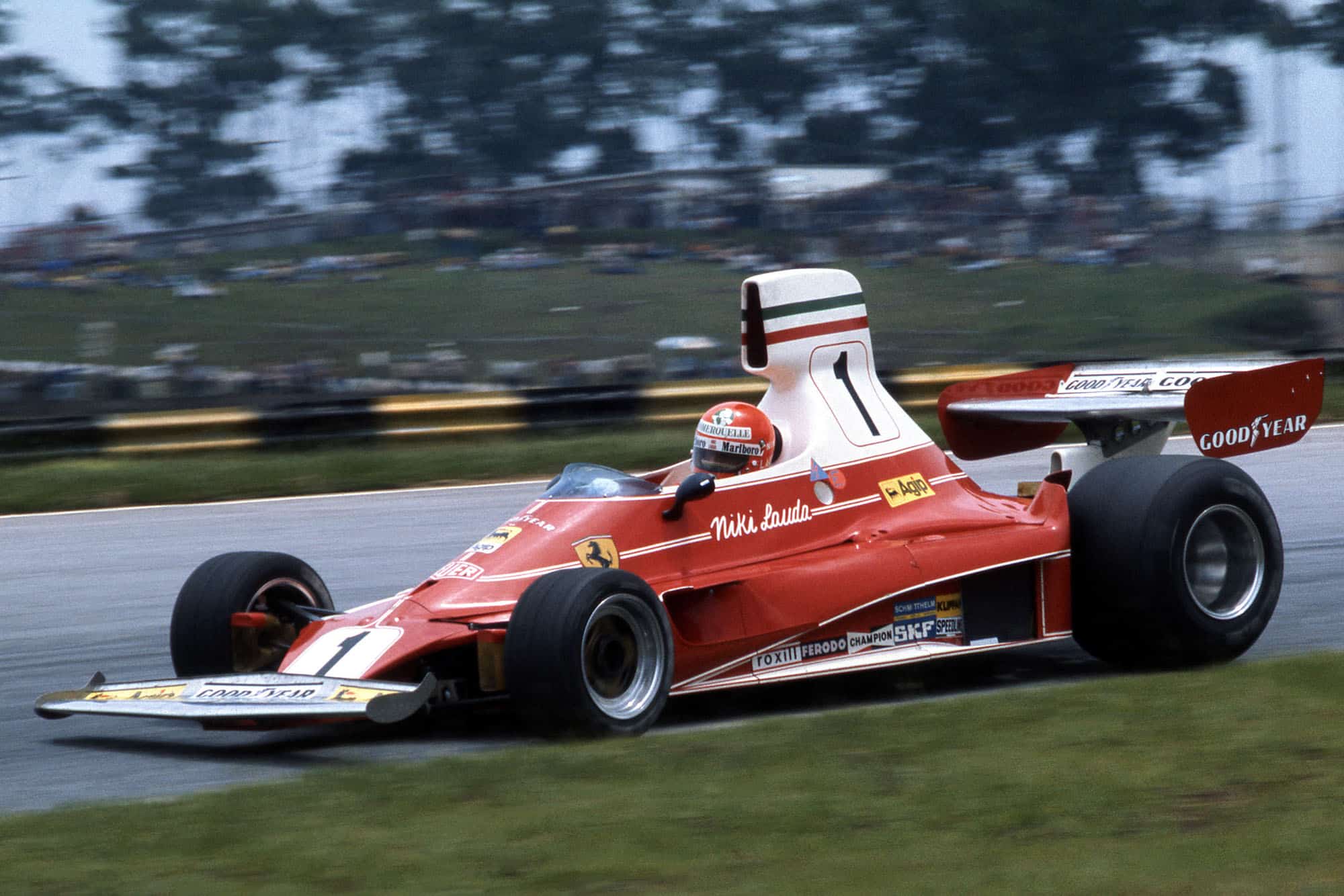
Niki Luda picked up where he left off last season with a win in Brazil
Motorsport Images
Lauda confirms Ferrari’s mastery
San Paulo, January 25th
The 1976 Grand Prix season started on a difficult note in January in the same way as the 1975 season ended last October. Having agreed that their race would take place, the Automovil Club Argentina abruptly announced the cancellation of the Argentine Grand Prix, due to take place in Buenos Aires’ Parc Almirante Brown on January 11th, thus throwing the Formula One Constructors’ Association and the Brazilian Grand Prix organisers into a state of considerable turmoil. So enormous are the air transportation costs for upwards of 20 Formula One cars that both Brazil and Argentina regularly divide this bill when the “circus” goes off to South America. Thus if the Brazilians wanted their Grand Prix, they were faced with the entire bill for airfreight in addition to the much increased prize fund.
Fortunately the Brazilian organisers didn’t have to deal with either the economic problems or the political unrest which currently beset their South American neighbour and the race took place as planned on January 25th. For the fourth consecutive year, Sao Paulo’s impressive 4.9-mile Interlagos circuit hosted the Grand Prix and more than usual interest attached to the Copersucar-financed team run by Wilson Fittipaldi Junior as they had now secured the services of his younger brother, twice World Champion Emerson, who has signed to drive for the team throughout the 1976 season. Apart from this amazing switch of allegiance on Fittipaldi’s part, the Brazilian Grand Prix marked the start of the 1976 season “proper” for such teams as Martini Brabham, Ligier Gitanes, John Player Team Lotus, Frank Williams, Penske Racing and March Engineering, all these teams arriving fully prepared with the cars they intend to use in all 15 races on this year’s Championship calendar. Ferrari, McLaren, Shadow, BRM1 and Elf Team Tyrrell were really taking part in the 15th race of the 1975 season, all relying on well-proven cars which they raced all through last year, albeit somewhat modified in many areas.
At the head of the entry list, swapping numbers 11 and 12 with McLaren Racing for numbers 1 and 2 in the “official line-up”, was the Championship winning Ferrari team, World Champion driver Niki Lauda this year being the man who carries “number one” on the side of his car as befits recent practice. Although they have already unveiled the new Ferrari 312T2 with its optional De Dion rear suspension, and tested it extensively at their private test circuit, the Italian team played safe and arrived in Brazil with exactly the same 312Ts that had been used at Watkins Glen. Niki Lauda used chassis 023 and Clay Regazzoni 024, these two cars still relying on the powerful flat-12 cylinder 3-litre engine and clever transverse five-speed gearbox which proved so reliably competitive in Lauda’s hands last year. The only alteration to the cars was the addition of a tubular roll hoop over the instrument panel in accordance with the 1976 CSI safety regulations. The team also brought along a spare car, but this was never used in either practice or the race.
Having spent much of the winter experimenting with their fascinating six-wheeled Project 34 prototype, Ken Tyrrell’s team brought along two of their familiar 007 series machines for Jody Scheckter (007/6) and Frenchman Patrick Depailler (007/4). Designer Derek Gardner had spent some time over the winter preparing minor chassis improvements to the existing cars as no final decision has yet been made concerning the six-wheeler project. Similarly McLaren Racing were still using two of their successful M23 chassis, Fittipaldi’s position as team leader having been taken by former Hesketh team driver James Hunt. In an effort to narrow the gap to the Ferraris, these cars featured much lighter body panels and several other minor weight-saving additions such as the adoption of wishbone rear suspension instead of the familiar parallel lower link arrangement. But the most interesting aspect of the McLaren team line-up was the installation of specially altered six-speed Hewland gearboxes on both cars. They had been specially designed by the McLaren team and assembled with the aid of some components supplied by Hewland Engineering, the specialist gearbox builders at Maidenhead.
Despite the loss of their very generous sponsor, Universal Oil Products, Don Nichols’ AVS Shadow team appeared at Interlagos with the same driver line-up as was regular in 1975. Jean-Pierre Jarier, who so nearly won last year’s Brazilian Grand Prix, drove DN5/5B and Welshman Tom Pryce handled DN5/6B, the “B” suffix indicating that these particular cars had been built up round brand new monocoques to slightly different detail specification than their 1975 forebears. Designer Tony Southgate has quite obviously been told to “hang fire” on the completion of the first DN8 chassis—the team’s design scheduled for this year—until it is clear whether or not Shadow can continue for the whole season, so until then the “DN5Bs” will be raced. The alterations involve a much narrower front track, revised suspension geometry and a whole host of other detail changes designed to contribute to the Shadow’s mechanical reliability, an area in which there has been some definite need for improvement.
Another team simply to update their design for 1976 is March Engineering, but although Robin Herd admitted that the latest March is really a “751B”, this prolific manufacturer adopted the nomenclature 761 for its new machines. Following very closely the uncomplicated and easily adjustable format of its predecessor, the 761 has been strengthened in accordance with the latest chassis safety regulations and has several slightly different body panels. Otherwise it’s very much “the mixture as before” with Vittorio Brambilla, Hans Stuck Junior and Leila Lombardi doing the driving just as they did last year. A great deal of complicated shuffling has taken place in the Frank Williams Team this never-say-die private owner taking over the Hesketh 308C project after the youthful Peer became bored with motor racing and decided to pack up his team. While Hesketh’s driver James Hunt found fresh employment at McLaren Racing, his designer Harvey Postlethwaite chose to follow his interesting new project to the Williams team and so continue to preside over the novel rubber suspended machine which should correctly be dubbed the “Hesketh-Williams, for similar reasons to those which gave rise to the Lancia-Ferraris some twenty years ago. Now carrying the chassis number FW/05, the “Hesketh-Wilhams” carries a smart gold pinstriped blue livery and benefits from the financial backing of international entrepreneur Walter Wolf. The only question-mark in this particular equation seemed to be just why Jacky Ickx had been recruited to drive it, a question which was to become increasingly pressing as the weekend wore on.
Williams also brought along the newest of the 1975 machines, FW/04, for Renzo Zorzi to handle, this inexperienced Italian being the lad who won last year’s Monaco F3 race and subsequently drove for the team in the Italian Grand Prix. Other familiar cars including Roger Penske’s pair of PC3s, a March-inspired but Penske-constructed machine, for John Watson to choose from. The first of these cars made its debut at Watkins Glen last October only to fail at the start of the race, obliging Watson to take over the team’s older PC1. Having dealt with the familiar machines, there was plenty more to see in the shape of “first timers”. Colin Chapman’s striking pair of new Grand Prix machines-call them John Player Specials if you must, but the Lotus boss confirmed to us that they are 77s as far as the history books ate concerned – appeared for the first time since Peterson tested at Paul Ricard some time ago. Much is hoped for from the new Lotuses and it was decided to run them at Interlagos with their “narrow track, short wheelbase” guise which can be selected from their several potential chassis configurations. Stronger and stiffer brake calipers had been fitted to the front of the 77s as a result of the team’s tests and the air is now ducted to the Cosworth DFV’s inlet trumpets by means of apertures either side of the windscreen which run the length of the cockpit side in the fashion of the Ferrari 312T2.
Drivers on this occasion were Peterson in the newest car (JPS/12 or 77/R2) and Mario Andretti in JPS/11 (77/R1), the American being engaged for this one race alone. Casting aside the taunts of those doubters who predicted doom to the project, Bernie Ecclestone’s Brabham team threw their entire Formula One effort into the ambitious Alfa Romeo-powered project and the new Gordon Murray-designed BT45 chassis. This machine relies on the 3-litre flat-12 cylinder Alfa Romeo unit which the Italian marque used to win the World Championship for Makes last year, an engine which has been the subject of a great deal of test and development since the 1975 racing season. Now carrying a tasteful red livery to replace the team’s predominantly white colour scheme of the past year, the Martini Brabham-Alfas were impeccably prepared cars. Unfortunately the addition of bigger front brakes and various other modifications means that they are wdll over the minimum weight limit for Formula One and their testing results had hardly proved encouraging. Nevertheless, such an enterprising effort should be encouraged and it would be wrong to pre-judge their potential particularly as Alfa Romeo are still in the process of “finding their feet” in the world of Grand Prix racing. Another “Non-Cosworth” newcomer is the Gitanes cigarette-sponsored Ligier JS5, a single car effort mounted by former Formula One privateer Guy Ligier who owned and drove his own Cooper-Maserati and Brabham-Repco in the mid-1960s. Although this team is new, its engine is not for the Ligier’s power comes from a Matra V12 unit similar to that which powered the French team’s successful 3-litre prototype in the past and was last seen in F1 in 1972. The Ligier has a rather conventionally laid out chassis, but it is an open secret that a considerable amount of Matra expertise has gone into its design. Appropriately, Jacques Laffite makes it an all-French effort by doing the driving, the 1975 European Formula Two Champion having left Frank Williams to do so. Finally, BRM would have us believe that their modified P201 V12 was a “new car”; in fact it’s a revised version of the chassis raced at Interlagos last year by Mike Wilds, now equipped with divided front radiators and outboard front brakes.
Of course, most of the Brazilian attention focused around the Fittipaldi team. Having spent last year slowly learning about the business of Formula One racing in a quiet, unobtrusive fashion, suddenly this little organisation pulled off a major coup in securing Emerson Fittipaldi’s services for 1976. The new “Copersucar” is a totally fresh design, owing nothing except experience to the rather bulky affair driven by Wilson Fittipaldi last season. It is clear that designer Richard Divila has closely scrutinised the cars of his rival teams and the result of this scrutiny is a very conventional Cosworth/Hewland “kit car” with conventional suspension, outboard brakes at the front and inboard brakes at the rear. Emerson Fittipaldi spent some time testing the car a week or so prior to the race and there seemed every indication to suggest that the new Fittipaldi car would at least be competitive amongst the Cosworth runners.
Qualifying
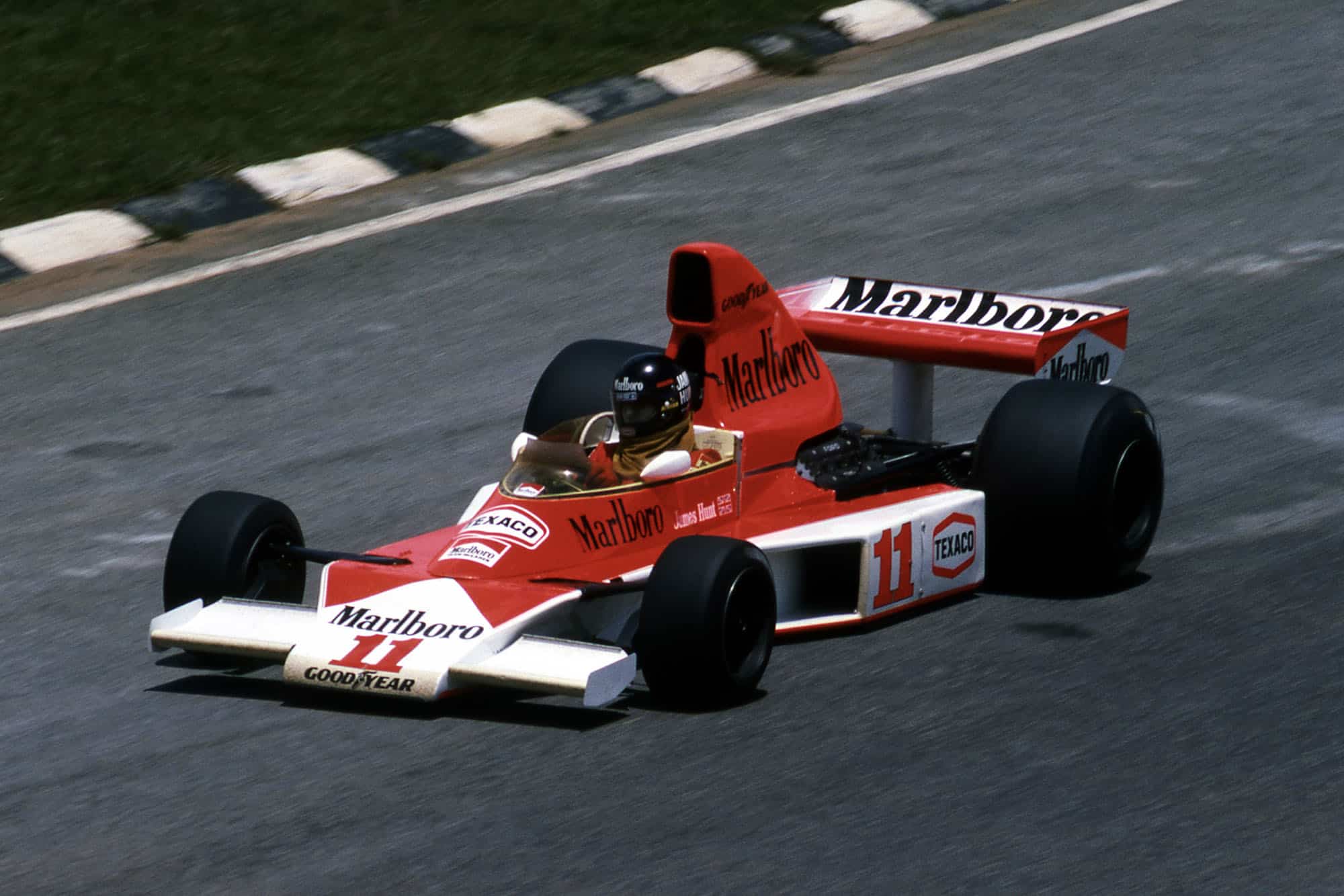
New McLaren recruit James Hunt put his car on pole
Motorsport Images
Practice took place on the Friday and Saturday prior to the race, conforming to the now customary pattern of two sessions on each day. This time the Formula One Association had thought up another “rule” which meant that the third session (i.e., the first session on Saturday) should not count for grid positions so that everyone could carry out “full tank tests and suchlike” without having to worry about being “caught napping” by more organised rivals. As far as Ronnie Peterson was concerned, he quickly got himself involved in problems the gravity of which far out-stripped minor grumbles about the revised practice schedule; he crashed his Lotus 77 very heavily after about five laps of the first session, sliding heavily through a catch fence when a screw-on nut disconnected itself from the temperature gauge bulb and allowed hot water to spray onto a rear tyre. Although the car was repairable, the effort required a sleepless night on the part of the Lotus mechanics and there were still plenty of problems waiting the next day. By the end of the first session, everything seemed to be fitting into the predictable 1975 pattern. Lauda and Regazzoni headed the practice list with laps of 2 min. 32.68 sec. and 2 min. 33.17 sec. respectively, their Ferraris looking as smooth, controlled and undramatic as ever round the 4.9 miles of bumps and rippled tarmac. Emerson Fittipaldi prompted all his other rivals to wake up with a start by taking the Copersucar round in 1 min. 33.33 sec., the grin on his face at the time reflecting the wisdom of a few days’ testing before official practice got under way. Nevertheless, Hunt was proving a very able successor to the Brazilian, lapping his six-speed McLaren in 2 min. 33.87 sec. during the first session to be fourth overall although team-mate Mass went even quicker by the end of the second session.
Neither of the Shadow DN5s showed much form on Friday, Jarier’s missing virtually all the first session after its differential packed up and Pryce complaining about his car’s handling. The following day the Shadows were to find their situation much improved only to fall foul of the “non-timed” third session and end up farther back on the grid than they would otherwise have been. The Fittipaldi and Penske teams also found themselves penalised by this strange anomaly and one wonders whether it will become a permanent feature of every Grand Prix on the calendar. Laffite made a good impression with the Ligier JS5, lapping smoothly in 2 min. 34.67 sec., the French V12 conspicuously eclipsing the Brabham-Alfa’s rather lack-lustre performance. On Friday both Reutemann and Pace popped and banged their way round the circuit so badly that the team’s sole priority was to get the engines to function cleanly. In an effort to establish which fuel injection system was the most efficient, Reutemann’s car was fitted with a Lucas unit for the Second day, replacing the much heavier Alfa Romeo system which added about 10 kilogrammes to the total weight of the car. But the Brabham team was also in trouble with gear selection problems on one car, failing rubber driveshaft joints on the other and spent much of Friday night fabricating two “bridge pieces” to fit across the tops of the gearboxes on both cars in an effort to prevent the flexing motion of which both drivers complained. Down in the Lotus pit a night’s work was rewarded with the failure of a joint at the bottom of the steering column on Peterson’s 77, a failure which meant the Swede missing the unofficial session on Saturday morning and left him with the job of setting the car up and catching up all the lost ground in the final hour-long session in the afternoon. Andretti was having a hard time in the other new Lotus, bucking and twitching an alarming path round the circuit, the driver feeling a little bit cautious about his car’s potential. When the chequered flag came out to mark the end of that final session, Lotus fortunes looked as low as they’ve ever looked with both cars right down at the back of the grid. It would he shortsighted in the extreme to write off Chapman’s new design as a failure at this early stage, but nonetheless it proved a very disheartening weekend for the British team.
Meanwhile, Ferrari were not getting it all their own way at the front of the grid. Jarier proved that his car’s superiority in last year’s event was no fluke and lapped his DNS in 2 min. 32.38 sec. during that unofficial session, easily faster than all the opposition. But in the session that mattered, the final hour, James Hunt put in a tremendous spurt to set fastest official time of the weekend with an excellent 2 min. 32.50 sec., even though the slightly re-profiled left-hander after the pits meant that he was significantly slower than Jarier’s 1975 pole-winning best of 2 min. 29.8 sec. Lauda wasn’t particularly ruffled by the McLaren driver’s performance, claiming second place on the grid just 0.2 sec. slower—confident that his car had more to offer on race day. Jarier managed to pip Regazzoni for the inside of row two, but a disappointed Tom Pryce ended up way back on the outside of row six after his engine turned sour in the final session.
Emerson Fittipaldi raised Brazil’s hopes with a competitive 2 min. 33.33 sec., best in the new Copersucar-Fittipaldi, praising his new car’s handling even though he strained a ligament in one of his arms during Saturday practice due to the heavy steering. Jochen Mass had virtually kept pace with team-mate Hunt right up until the final session only to have any chance of improvement vanish when the automatic fire extinguisher system accidentally went off in his McLaren’s cockpit and Watson’s very competitive Penske was similarly handicapped after running out of petrol. A similar affliction halted the works Marches while Laffite was very fortunate to escape unhurt when a rear wheel collapsed on the Ligier and spun the French car into the catch fencing very hard; fortunately the damage proved to be superficial and the Copersucar team offered them sonic help in strengthening their retnaining rear rims so that the Matra V12 could take part in the first Grand Prix of 1976.
Both Brabham drivers tried tremendously hard with their Alfa-engined mounts, Pace and Reutemann looking very dramatic all round the circuit as they strove for a competitive time. In the event Pace qualified on the fifth row just behind Depailler’s Tyrrell and ahead of the Ligier-Matra, but Jody Scheckter just couldn’t get his Tyrrell to handle to his liking and failed to break the 2 min. 35 sec. barrier. Back with the troubled Lotus duo were Frank Williams’ cars, and the fact that Ickx couldn’t lap the Hesketh-Williams as quickly as Zorzi’s FW/04 made one wonder just why the Belgian had returned to single-seater racing. Right at the back came Brazilian novice Ingo Hoffman in the old Copersucar-Tittipaldi FD/03, Ashley’s uncompetitive BRM and Signorina Lombardi’s March 761.
Race
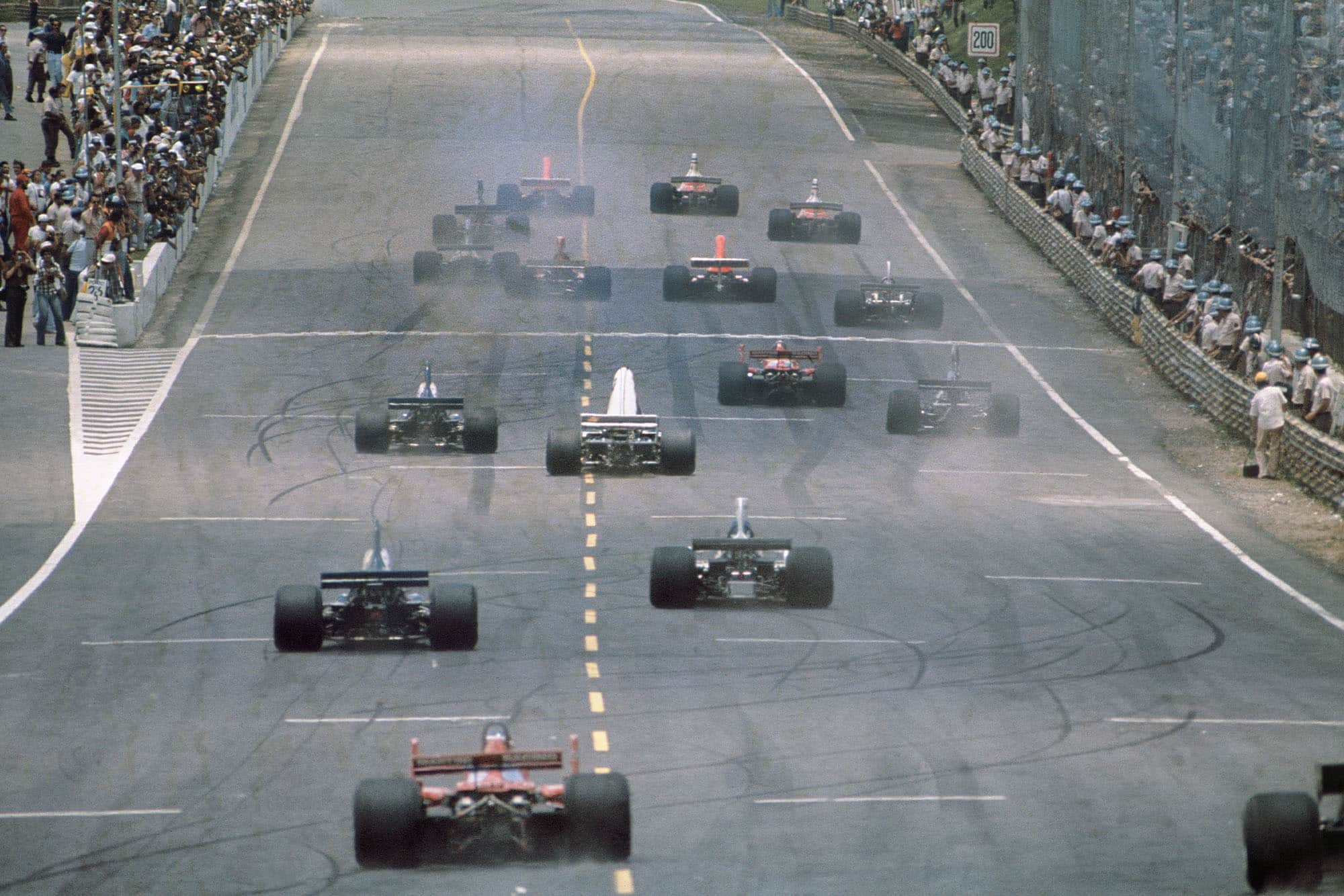
The cars pull away at the start of the race
Motorsport Images
After a spell of rather changeable weather during the previous week, a scorching day was predicted for the Sunday and so it proved, with temperatures up in the nineties. Inevitably the open stands were packed with thousands of partisan supporters waving a host of Brazilian flags in support of Fittipaldi, Pace and even Hoffman but in reality it seemed unlikely that a home victory was really on the cards. There was a good deal of smiling going on in the McLaren pit as Hunt’s M23 lined up on pole position, the young English driver having gone some way towards compensating for what Teddy Mayer felt was Fittipaldi’s abrupt departure from the team last October. But when the green starting light flashed on as the cars moved forward from the dummy grid in ragged formation, Regazzoni’s Ferrari dodged between his team-mate and Hunt and dived into the first corner in the lead.
All the way up through the infield loops and back into the long startline straight Lauda harassed Regazzoni, but the Swiss wasn’t giving up without a fight and Hunt found himself able to hang onto the Italian cars as long as Regazzoni stayed ahead. In fourth place Brambilla temporarily fended off Jarier’s Shadow and then it was Mass, Watson, Farina!di, Pryce, Depailler, Scheckter, Pace, Lailite, Stuck, Andretti, Peterson, Reutemann, Zorzi, Hoffman, Ickx, Ashley and Lombardi, the lastnamed trailing into the pits to have her March’s sticking throttle slides cleared. As long as Regazzoni led the race it was clear that he was going to have a tight queue banking up behind him. Jarier nipped past Brambilla and didn’t take long to latch on behind Hunt’s McLaren, so by lap six there was a tight quartet disputing the lead. Mass had already been delayed after a slight brush with the Frenchman’s Shadow, the second McLaren dropping back to the tail of the field after stopping to have a replacement nose section fitted, and Brambilla quickly dropped back behind Pryce as his March’s steering began to feel a bit sloppy. The World Champion appreciated that he had to make a break early in the race for he too had glanced down the list of unofficial practice times the previous morning and had realised that Jarier would be the man to give him most trouble. Consequently he made a supreme effort on the ninth lap, got alongside his team-mate as they sped down the long straight after the pits and edged Regazzoni out of first place under braking at the end of it. Almost immediately, Hunt followed him through and Jarier, getting a little nervous that he might be left behind, cut things a little too fine as he tried to dive inside the Swiss’ Ferrari going into a fast downhill right-hander. His Shadow hit the Ferrari’s right front wheel a hefty blow, breaking the rim and deflating the tyre, leaving Regazzoni no alternative but to drive slowly round to the pits and get the wheel changed.
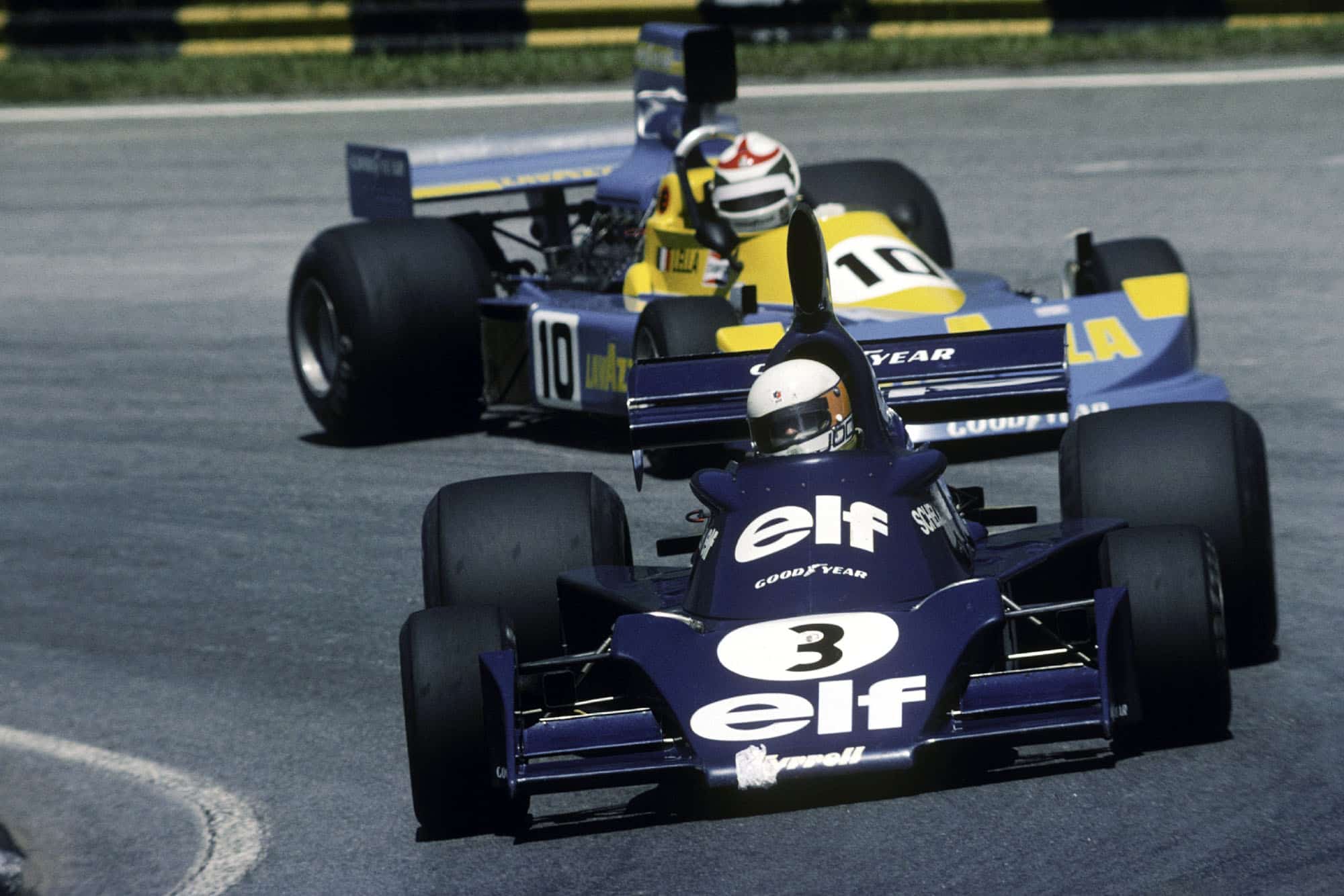
Jody Scheckter keeps his Tyrrell ahead of Lella Lombardi’s March
Motorsport Images
But whilst this drama was going on behind, Niki Lauda began steadily pulling away from his pursuers leaving Jarier the problem of getting past Hunt before he could have a crack at the leading Ferrari. Pryce underlined the challenge from the Shadow team ahead of Depailler’s Tyrrell for Brambilla had been forced into the pits for a loose bolt to be tightened on the outer end of a track rod and Laffite’s Ligier had been halted by deranged gear linkage before it could climb too far up the field. As far as Team Lotus was concerned, all they wanted to do was to forget all about the 1976 Brazilian Grand Prix as Peterson managed to collide with his team-mate on the fifth lap, eliminating Andretti on the spot with badly damaged suspension. The Swede stopped at the pits for brief repairs before resuming, but stopped four laps later complaining of low fuel pressure. One wonders just how much longer the potentially explosive situation currently existing between Chapman and Peterson can continue!
By half distance it really did look as though the race had developed into an impasse. Lauda was comfortably out in front, extending his lead slightly all the time, as Jarier became locked in a ferocious scrap with Hunt, the Shadow driver trying every untidy trick in the book in his attempts to get past the McLaren. But Hunt wasn’t being intimidated and, by the expedient of keeping cool and not getting ragged, stayed a few yards ahead of his rival until his DFV lapsed onto seven cylinders and he was forced to concede second place. An injection trumpet had worked loose on the McLaren’s DFV, dropping down and jamming the throttle mechanism as well as depriving one cylinder of its fuel. Once past Hunt, Jarier began to make an impression on Lauda’s lead, closing on the Ferrari at about over a second a lap but looking very erratic as he did so and left the McLaren dropping farther and farther behind, now further troubled with an intermittently sticking throttle to add to his other difficulties. Pryce was still hanging on in fourth place ahead of Depailler, Stuck’s consistent driving had taken him up into fifth place and Fittipaldi was now right out of things after making a pit stop to investigate the reason behind his engine’s erratic misfire ever since the opening lap. The spark box was replaced during this stop in lap 25, but the new Copersucar-Fittipaldi still misfired seriously but E. F. was very conscious of his obligation to the fans and continued to drive round at the back of the field until the end of the race.
Lauda didn’t look unduly flustered by Jarier’s progress, but he was nevertheless losing ground at a considerable rate and it was obvious that the Shadow would be on his tail within a couple of laps. It would be one thing to catch the Ferrari but something else to actually pass the little Austrian, but Jarier never got the chance of getting close enough to make a bid for the lead. James Hunt’s sticking throttle spun the McLaren into the catch fencing on a fast downhill right-hander and the damage to the rearmounted oil coolers resulted in his laying an oil slick down the short straight that followed as he drove slowly away. On lap 34 the leaders appeared, Lauda less than a couple of seconds ahead, and although the Ferrari successfully negotiated the slippery surface at the entrance to the following left-hander, Jarier failed to make it and slid gently on into the barriers. Pryce only just managed to scrabble round the corner in an undignified series of twitches but he was already grappling with worn tyres and failing brakes so Depailler quickly took this opportunity of moving into what was now second place.
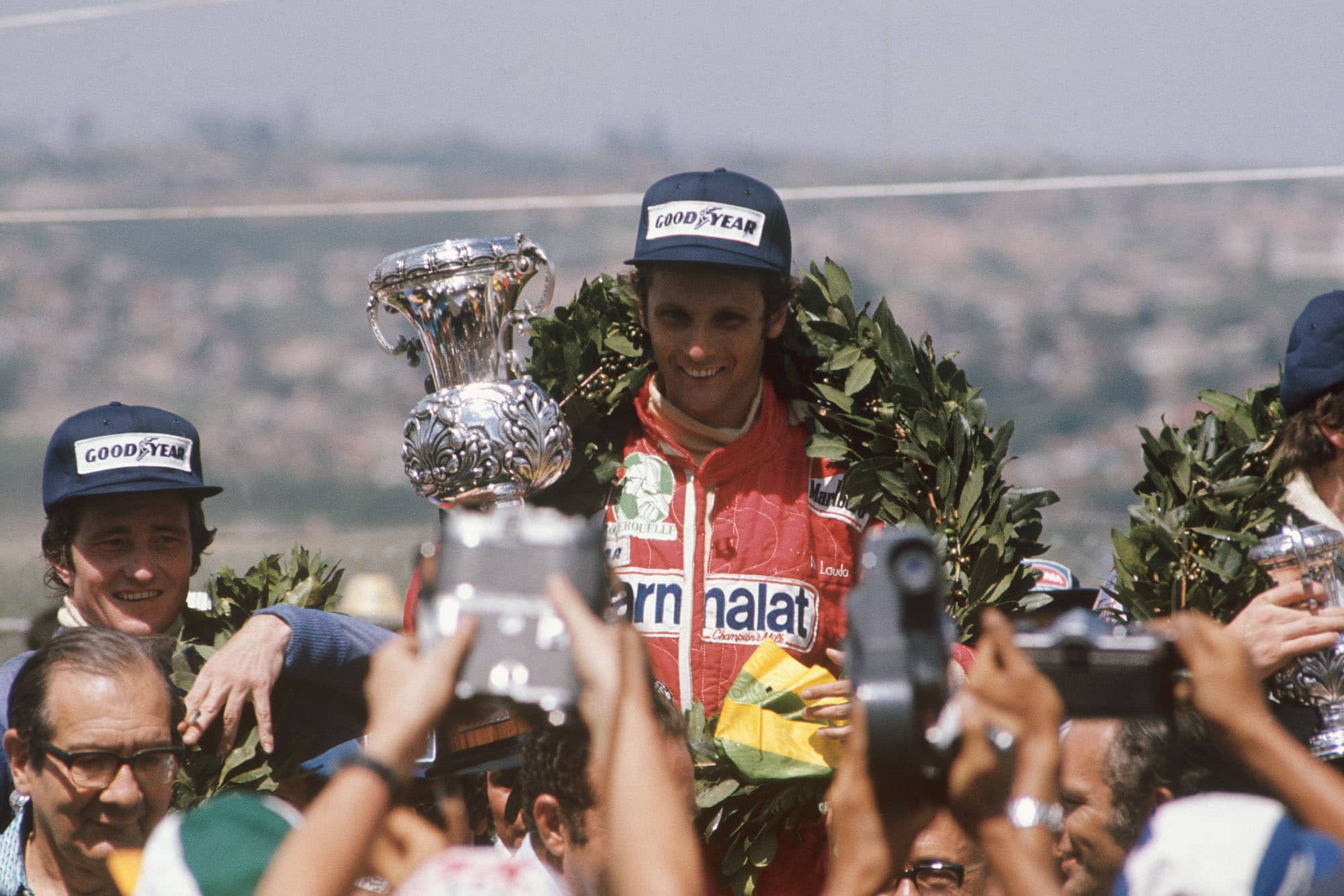
Lauda stands atop the podium
Motorsport Images
Thus the race ran out with Lauda a confident and controlled winner, the Ferrari 312B3(T) sounding as crisp and healthy at the end of the 40-lap Grand Prix as it had at the start. Depailler’s plucky efforts with the Tyrrell were well rewarded with second place and Pryce was glad to finish third in a race which again had promised such a great deal from the Shadow DN5s before Jarier’s unfortunate misjudgement. Stuck and Scheckter finished in the next two places, well spaced out, while both Mass and Reggazzoni climbed up through the field in praiseworthy style following their pit stops., even beating the unimpressive Ickx who could manage no better than eighth in the HeskethWilliams despite a non-stop run.—A.H.
